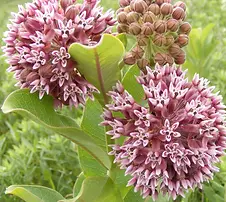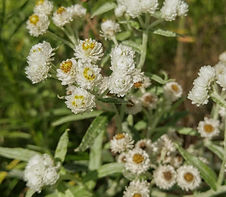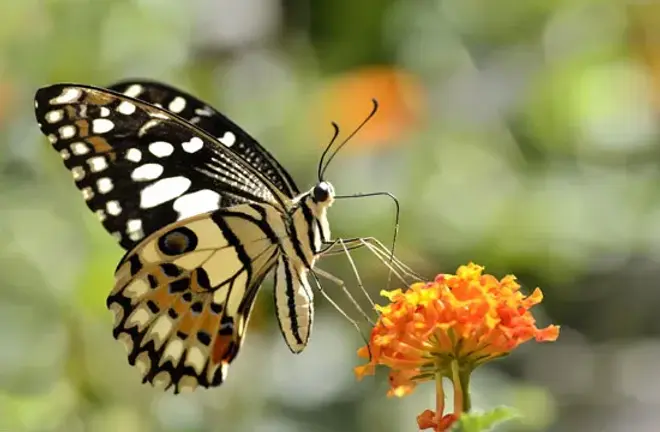Planting for
the Planet
Native Plants and Butterflies
Butterflies are critical components of ecosystems for a multitude of reasons, a major one being pollination of various plant species. Unfortunately, with the introduction and selection of non native species we are losing important butterfly species due to reduction of availability in both their host and nectar plants. As butterflies require both in order to survive, it is important to ensure each component remains available to conserve butterfly populations and thereby other plant species.

Host Plants
Butterflies require host plants to provide a safe area to lay their eggs, and later provide food for the hatched caterpillars. Therefore, host plants are essential for butterfly reproduction, and many species require specific plants to obtain their nutrition. Because of this specificity, it is important to garden with plants used by local pollinators.
(Erickson, 2019)
Below are examples of native host plants.
Photo retrieved from: Roads End Naturalist


Common Milkweed
Asclepias syriaca
Critical Host plant for the endangered Monarch Butterfly, as this butterfly only breeds on milkweed species.
Mature size: 2-4ft height, 24-30in spread
Sun exposure: full sun
Soil type: dry, well drained
(Beaulieu, 2010)
Buy Here:
https://davenportgarden.com/products/common-milkweed-asclepias-syriac-native-perennial
Photo Retrieved From: Davenport Garden Center

Pearly Everlasting
Anaphalis margaritacea
Host plant to the American Painted Lady, a butterfly native to Ontario. This plant can handle harsh conditions and spreads quickly!
Mature size: 2ft heigt and spread
Sun exposure: partial to full sun
Soil type: sandy loam
(Ontario Native Plants, n.d.-a)
Buy Here:
https://onplants.ca/shop/anaphalis-margaritacea/
Photo Retrieved From: Ontario Native Plants

Spotted Joe-Pye Weed
Eutrochium maculatum
Serves as host plant and attracts dozens of butterfly species, while also being deer resistant.
Mature size: 7ft height, 3ft spread
Sun exposure: partial to full sun
Soil type: clay-loam, organic
(Ontario Native Plants, n.d.-b)
Buy Here:
https://onplants.ca/shop/eupatorium-maculatum/
Photo Retrieved From: Ontario Native Plants

Nectar Plants
Simply having host plants is not enough to support butterflies, and plants that act as nectar sources are critical to creating a butterfly garden. Adult butterflies locate and select plants based on visual cues, making it essential gardeners plant the correct species to obtain visitors and help conserve species.
(Reddi & Bai, 1984)
Below are examples of native nectar plants.
Photo Retrieved From: Britannica Kids

References
Beaulieu, D. (2010). How to Grow and Care for Common Milkweed. The Spruce. https://www.thespruce.com/milkweed-plants-monarch-butterfly-host-2132954
Beaulieu, D. (2022, September 12). How to Grow New England Asters. The Spruce. https://www.thespruce.com/how-to-grow-new-england-asters-4109086
Davenport Garden Centre. (n.d.). Common Milkweed (Asclepias Syriaca) . Davenport Garden Centre. https://davenportgarden.com/products/common-milkweed-asclepias-syriac-native-perennial
Erickson, B. (2019, March 20). Butterfly host plants. The Corner Pollinator Garden and Wildlife Habitat. https://cornerpollinatorgarden.net/butterflies/
Mahr, S. (n.d.). Butterflyweed, Asclepias tuberosa. Wisconsin Horticulture. https://hort.extension.wisc.edu/articles/butterflyweed-asclepias-tuberosa/
Musat, C. (n.d.). butterfly: eating nectar. Britannica Kids. Retrieved March 9, 2024, from https://kids.britannica.com/students/assembly/view/270093
Ontario Native Plants. (n.d.-a). Pearly Everlasting - Shop - Ontario Native Plants. Onplants.ca. Retrieved March 9, 2024, from https://onplants.ca/shop/anaphalis-margaritacea/
Ontario Native Plants. (n.d.-b). Spotted Joe Pye - Shop - Ontario Native Plants. Onplants.ca. Retrieved March 9, 2024, from https://onplants.ca/shop/eupatorium-maculatum/
Reddi, C. S., & Bai, G. M. (1984). Butterflies and pollination biology. Proceedings: Animal Sciences, 93(4), 391–396. https://doi.org/10.1007/bf03186258
RoadsEndNaturalist. (2013, March 25). Image Gallery. Roads End Naturalist. https://roadsendnaturalist.com/gallery/
Vega, J. (n.d.). Symphyotrichum cordifolium (Blue Wood Aster). Gardenia.net. https://www.gardenia.net/plant/symphyotrichum-cordifolium


